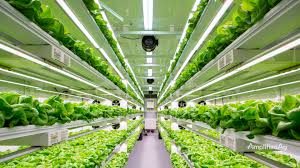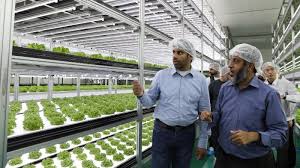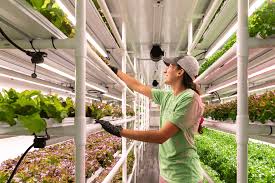Vertical farming is an innovative agricultural method that allows crops to be grown in stacked layers or vertically inclined surfaces, often within controlled environments.
This technique is gaining popularity as a solution to the limitations of traditional farming, particularly in urban settings where land is limited and demand for fresh produce is high.
However, while vertical farming offers numerous benefits, it also presents a unique set of challenges that must be addressed for its successful implementation. This article explores the technological aspects of vertical farming and the economic, technical, and operational challenges it faces.
Overview of Vertical Farming Technology
Vertical farming incorporates various technologies to create optimal growing conditions for plants. Key components include:
1. Hydroponics, Aeroponics, and Aquaponics: These soil-less farming methods use nutrient-rich water solutions, mist, or a combination of both to nourish plants, promoting faster growth and higher yields.
2. Climate Control Systems: Advanced climate control technologies allow for the regulation of temperature, humidity, and light levels, ensuring that plants receive the ideal conditions for growth.
3. Automated Systems: Automation, including sensors and monitoring devices, helps manage growing conditions and optimize resource use, minimizing human intervention.
Economic Challenges

While vertical farming has the potential for profitability, several economic challenges can hinder its success:
1. High Initial Investment: Establishing a vertical farm requires significant capital for technology, infrastructure, and operational systems. This high initial cost can be a barrier for many potential farmers.
2. Operational Costs: Running a vertical farm often involves ongoing expenses for energy, water, and nutrient supplies. High energy consumption, particularly for lighting and climate control, can significantly impact profit margins.
3. Market Competition: Vertical farmers may face competition from traditional agriculture and other food production methods. Building consumer awareness and demand for vertically farmed products is essential to ensure profitability.
Read Also: The Principles of Goat Production for Maximum Production
Technical and Operational Challenges

In addition to economic hurdles, vertical farming also encounters various technical and operational challenges:
1. Technical Expertise: Successful vertical farming requires specialized knowledge in various areas, including plant biology, horticulture, and technology management. This expertise may be lacking in potential farmers, necessitating training and education.
2. Reliability of Technology: Dependence on technology means that any malfunction or failure in systems like climate control or automated feeding can severely impact crop health and yields. Regular maintenance and monitoring are essential to mitigate these risks.
3. Pest and Disease Management: Although vertical farms often use controlled environments to reduce pests and diseases, they are not immune. Managing pests and diseases in a confined space can be challenging, and growers must implement effective strategies for prevention and control.
4. Limited Crop Variety: Not all crops are suitable for vertical farming, and some may require specific conditions that are difficult to replicate in vertical systems. Identifying which crops are best suited for vertical farming is crucial for optimizing yields and profitability.
Environmental Concerns
Vertical farming, while often seen as a sustainable solution, has its environmental challenges:
1. Energy Consumption: Vertical farms rely heavily on artificial lighting and climate control systems to create optimal growing conditions. This can lead to high energy consumption, which may contribute to greenhouse gas emissions if the energy source is not renewable.
2. Water Usage: Although vertical farms often use hydroponic systems that can be more efficient than traditional farming, there are still concerns about water usage, particularly in regions where water scarcity is an issue.
3. Waste Management: Managing waste from vertical farms, including plant residues and used growing media, can pose environmental challenges. Sustainable waste disposal methods must be developed to minimize the environmental impact.
Read Also: Layers Management: Pullets (Day Old Chicks) Vs Point of Lay (Layers) which is Better?
Regulatory and Policy Issues

The growth of vertical farming also faces various regulatory and policy hurdles:
1. Zoning Laws: Urban zoning laws may not always accommodate vertical farms. Farmers may need to navigate complex regulations to obtain the necessary permits for construction and operation.
2. Food Safety Regulations: Ensuring food safety in vertically farmed products can be challenging, particularly concerning the use of hydroponics and aquaponics. Compliance with food safety regulations is crucial for market access and consumer confidence.
3. Financial Incentives and Support: Government policies can significantly impact the viability of vertical farms. Lack of financial incentives or support for innovative farming practices may hinder the growth of vertical farming initiatives.
Market Acceptance and Consumer Perception
Consumer perception and market acceptance are critical factors for the success of vertical farming:
1. Awareness and Education: Many consumers are unfamiliar with vertical farming and its benefits. Raising awareness and educating consumers about the advantages of locally grown, fresh produce can help improve market acceptance.
2. Price Competition: Vertical farm products may be priced higher than traditionally farmed products due to the higher operational costs. Competing with lower-priced conventional produce can be a significant challenge.
3. Perceived Quality: Some consumers may question the quality of vertically farmed produce compared to traditional farming methods. Establishing a reputation for high-quality products is essential for gaining consumer trust.
Future Prospects and Innovations
Despite the challenges, the future of vertical farming is promising, driven by ongoing innovations:
1. Technological Advancements: Continued advancements in agricultural technology, including more efficient lighting systems, automated farming equipment, and improved growing systems, can help reduce operational costs and improve crop yields.
2. Integration with Urban Planning: As cities increasingly focus on sustainability, integrating vertical farms into urban planning can promote local food production and reduce transportation emissions.
3. Research and Development: Ongoing research into plant varieties best suited for vertical farming, pest management, and resource optimization will enhance the viability and sustainability of vertical farming systems.
Vertical farming represents a promising solution to the challenges of traditional agriculture, particularly in urban environments. However, to fully realize its potential, the industry must address various economic, technical, and operational challenges.
By overcoming these hurdles, vertical farming can play a vital role in sustainable food production and contribute to food security in growing urban populations.
As technology continues to evolve, so too does the potential for vertical farming to become a mainstream agricultural practice.
Do you have any questions, suggestions, or contributions? If so, please feel free to use the comment box below to share your thoughts. We also encourage you to kindly share this information with others who might benefit from it. Since we can’t reach everyone at once, we truly appreciate your help in spreading the word. Thank you so much for your support and for sharing!
Read Also: Tips for Maintaining a Clean Garbage Disposal
